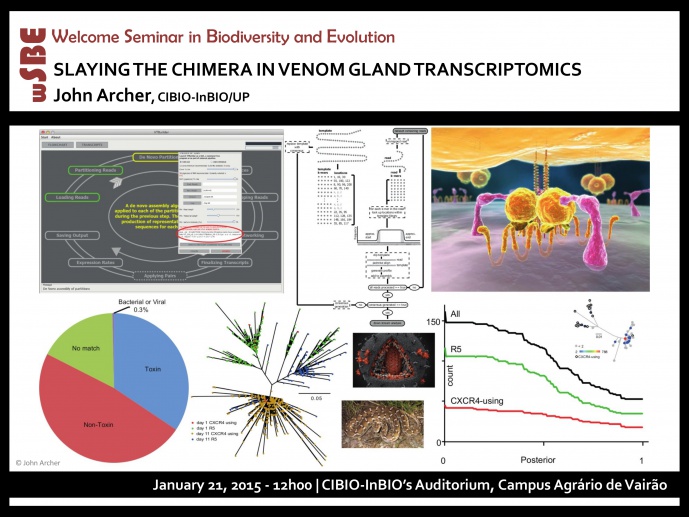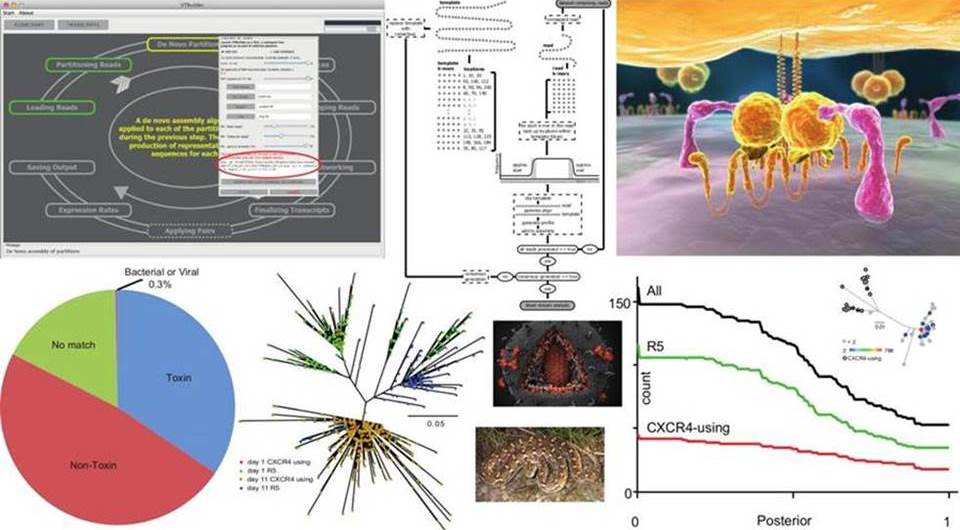SLAYING THE CHIMERA IN VENOM GLAND TRANSCRIPTOMICS

WELCOME SEMINAR IN BIODIVERSITY AND EVOLUTION

Within many research areas, such as transcriptomics, the millions of short DNA fragments (reads) produced by current sequencing platforms need to be assembled into transcript sequences before they can be utilized. Despite recent advances in assembly software, creating such transcripts from read data harboring isoform variation remains challenging. This is because current approaches fail to identify all variants present or they create chimeric transcripts within which relationships between co-evolving sites and other evolutionary factors are disrupted. Here I present VTBuilder, a tool for constructing non-chimeric transcripts from read data that has been sequenced from sources containing isoform complexity.
VTBuilder was validated using reads simulated from 54 Sanger sequenced transcripts (SSTs) expressed in the venom gland of the saw scaled viper, Echis ocellatus. The SSTs were selected to represent genes from major co-expressed toxin groups known to harbor isoform variants. From the simulated reads, VTBuilder constructed 55 transcripts, 50 of which had a greater than 99% sequence similarity to 48 of the SSTs. In contrast, using the popular assembler tool Trinity, only 14 transcripts were constructed with a similar level of sequence identity to just 11 SSTs. Furthermore VTBuilder produced transcripts with a similar length distribution to the SSTs while those produced by Trinity were considerably shorter. To demonstrate that our approach can be scaled to real world data we assembled the venom gland transcriptome of the African puff adder Bitis arietans using paired-end reads sequenced on Illumina’s MiSeq platform. VTBuilder constructed 1481 transcripts from 5 million reads and, following annotation, all major toxin genes were recovered demonstrating reconstruction of complex underlying sequence and isoform diversity.
Unlike other approaches, VTBuilder strives to maintain the relationships between co-evolving sites within the constructed transcripts, and thus increases transcript utility for a wide range of research areas ranging from transcriptomics to phylogenetics and including the monitoring of drug resistant parasite populations. Additionally, improving the quality of transcripts assembled from read data will have an impact on future studies that query these data. VTBuilder has been implemented in java and is available, under the GPL GPU V0.3 license, from http://www.lstmed.ac.uk/vtbuilder.
John Archer graduated from the University of Liverpool in 2001 with an MSc in Software Engineering. From 2001 to 2005 John worked as a software developer in a Liverpool based IT company. In 2005 he started a PhD in the department of bioinformatics at the University of Manchester under the supervision of Prof. David Robertson. The project involved looking at the evolutionary dynamics of HIV-1 but progressed into developing software for the analysis of next generation sequence data. John’s main areas of interest were in characterizing the diversity found with the HIV-1, detecting recombinant breakpoints within HIV-1 genomes and tracking low frequency resistance mutations using next generation sequence (NGS) data. Following his PhD he remained in Manchester for six years as a postdoc working on projects related to the mapping and analysis of read data obtained from viral populations primarily HIV-1, influenza A (H1N1) and HCV. In 2013 John began a postdoc at the Liverpool School of Tropical Medicine where he was responsible for the development of a tool, called VTBuilder, for the assembly of venom gland transcriptomes. In the last month he has joined CIBIO-InBIO where he is looking forward to being involved in the establishment of a bioinformatics unit that will facilitate various projects within the institute as well as the continued creation of software tools that will meet the needs of the research community in general.
Image credits: John Archer